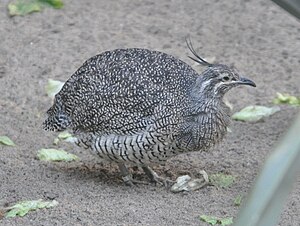Guinea fowl
| Guinea fowl | ||||||||||||
|---|---|---|---|---|---|---|---|---|---|---|---|---|

Guinea fowl ( Eudromia elegans ) |
||||||||||||
| Systematics | ||||||||||||
|
||||||||||||
| Scientific name | ||||||||||||
| Eudromia elegans | ||||||||||||
| I. Geoffroy Saint-Hilaire , 1832 |
The guinea fowl ( Eudromia elegans ) is a species from the cocoon family that is native to southern South America and is one of the resident birds there .
When fully grown, guinea fowl can reach a body length of 37 to 41 centimeters and weigh between 400 and 800 grams. It is characterized by the long hood, which is usually bent forward. The body plumage is light to dark brown. The wings have numerous white spots. A light stripe runs behind the eye, another below it.
Guinea fowl are relatively shy birds that live in small to medium-sized groups in wooded areas, grasslands, and in the bushes.
Subspecies
Ten subspecies have been described, which differ mainly in their coloration:
- Eudromia elegans elegans I. Geoffroy Saint-Hilaire , 1832 occurs in south-central Argentina.
- Eudromia elegans intermedia ( Dabbene & Lillo , 1913) is widespread in northwest Argentina.
- Eudromia elegans magnistriata Olrog , 1959 is common in north-central Argentina.
- Eudromia elegans riojana Olrog , 1959 occurs in western central Argentina.
- Eudromia elegans albida ( Wetmore , 1921) occurs in western central Argentina.
- Eudromia elegans wetmorei Banks , 1977 is common in western Argentina.
- Eudromia elegans multiguttata Conover , 1950 occurs in east-central Argentina.
- Eudromia elegans devia Conover , 1950 is widespread in southwest Argentina.
- Eudromia elegans patagonica Conover , 1950 is common in southern Chile and southern Argentina.
- Eudromia elegans numida Banks , 1977 is common in central Argentina.
literature
- David Burnie: Animals the Great Picture Encyclopedia. Dorling Kindersley Verlag GmbH, Munich 2001, ISBN 3831002029 .
- Isidore Geoffroy Saint-Hilaire: Eudromy. Eudromia. Isid. Geoff . In: Magasin de zoologie . tape 2 , Classe II, 1832, pp. 1–6, plate 1 (French, biodiversitylibrary.org ).
- Roberto Dabbene, Miguel Lillo: Description de deux nouvelles espèces d'oiseaux de la Républic Argentine. Un perroquet du genre Cyanolyseus et un tínamou du genre Calopezus . In: Anales del Museo Nacional de Historia Natural de Buenos Aires . tape 24 , 1913, pp. 187–194, plate 12 (French, biodiversitylibrary.org ).
- Claës Christian Olrog: Eudromia formosa (Lillo) and Eudromia elegans Is.Geoffrey (Aves, Tinamiformes) . In: Neotropica . tape 5 , 1959, pp. 13-21 .
- Alexander Wetmore: Three new birds of the family Tinamidae from South America . In: Journal of the Washington Academy of Sciences . tape 11 , 1921, pp. 434–437 (English, biodiversitylibrary.org ).
- Henry Boardman Conover: A study of the elegant tinamous, genus Eudromia . In: Fieldiana. Zoology. tape 31 , no. 38 , 1950, pp. 363–374 (English, biodiversitylibrary.org ).
- Richard Charles Banks: A Review Of The Crested Tinamous Aves Tinamidae . In: Proceedings of the Biological Society of Washington . tape 89 , 1977, pp. 529-544 (English, biodiversitylibrary.org ).
Web links
Commons : Guinea Fowl ( Eudromia elegans ) - Collection of images, videos and audio files
- Videos, photos and sound recordings of Eudromia elegans in the Internet Bird Collection
- Eudromia elegans inthe IUCN 2013 Red List of Threatened Species . Listed by: BirdLife International, 2012. Retrieved January 29, 2014.
Individual evidence
- ↑ IOC World Bird List ratites: Ostriches to Tinamous
- ↑ Isidore Geoffroy Saint-Hilaire (1832), p. 3, plate 1.
- ^ Roberto Dabbene (1913) and a., pp. 192, 194, plate 12.
- ^ A b Claës Christian Olrog (1959), p. 19.
- ↑ Alexander Wetmore (1921), p. 437.
- ^ Richard Charles Banks (1977), p. 537.
- ^ Henry Boardman Conover (1950), p. 367.
- ^ Henry Boardman Conover (1950), p. 369.
- ^ Henry Boardman Conover (1950), p. 364.
- ^ Richard Charles Banks (1977), p. 536.

